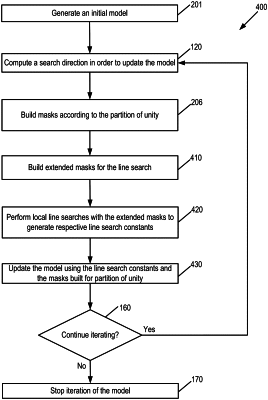| CPC G01V 99/005 (2013.01) [G06F 17/18 (2013.01); G06F 30/20 (2020.01); G06F 30/27 (2020.01); G06F 2111/10 (2020.01)] | 19 Claims |

|
1. A method of hydrocarbon prospecting, comprising:
computing, using a subsurface property model, an objective function measuring misfit between model-simulated data and measured geophysical data;
computing a search direction comprising a gradient in order to update the model;
partitioning the search direction, wherein partitioning the search direction comprises:
introducing a 3D partition of unity in image space; and
partitioning the gradient corresponding to the 3D partition of unity;
performing multiple line searches for the partitioned search direction in order to generate respective line search constants;
updating the model using the partitioned search direction and the respective line search constants; and
identifying potential hydrocarbon-bearing formations in a subsurface region with data from the updated model.
|